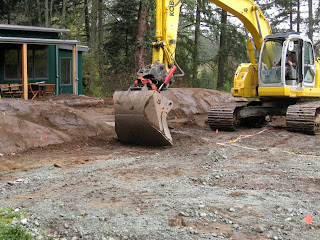Preparation for the construction of the next room included Tom doing a few tasks while he could still get the excavator into the areas.
One task was to lift the 2 Garden Towers off the balcony. Ron had removed all the railing in preparation for the conservatory construction which made lifting the Garden Towers easier.
For Tom, it was just a matter of lifting them off the balcony then rolling them off the bucket. Without the excavator, it would have been a major task requiring lots of preplanning and manpower (not girl power. I don't like doing those sorts of tasks).
The deer will be delighted when they discover these 2 picnic baskets set out for them. I am resigned to the plants all being eaten to nubs. We will replant the towers once the deer fence has been built.
In the meantime, the girl power is scraping up the last of the compost from the compost area and spreading it on existing garden beds. I didn't want to lose the compost we had made.
The critical task in preparation for the construction of the next garden room is the placement of needed materials where they are both accessible and out of the way of the construction.
Tom piled the decomposing logs on one side of the track downhill from the next lot of beds.
He piled up his specially mixed soil on the other side of the track.
More truckloads of rocks were delivered. Tom spoke to the driver each time. I think he asked for bigger rocks with every load. One truckload had only 8 rocks because they were so big. The rocks come from a construction site not far away where they are blasting out a mound to level the ground. With the rocks being local in origin they match perfectly the rocks used in the original construction of the house.
Tom's next task was to remove all of the existing plants I had tagged with tape because I wanted to keep them for the new beds. He put them out of the way of the construction area.
Let the construction of the Raised Rockbeds begin.





















































